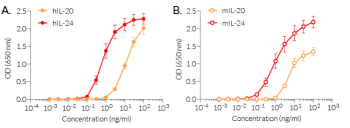Recombinant human IL-20
-
Cat.code:
rcyc-hil20NEW
- Documents
ABOUT
Human IL-20 protein - Mammalian cell-expressed, tag-free, carrier-free
Recombinant human IL-20 is a high-quality and biologically active cytokine, validated using proprietary IL-20 reporter cells. This member of the IL-10 cytokine family is produced in CHO cells to ensure protein glycosylation and bona fide 3D structure.
Recombinant human IL-20 can be used together with HEK-Blue™ IL-19/IL-20 cells for the screening of inhibitory molecules, such as Fletikumab, a therapeutic monoclonal antibody blocking IL-20 signaling (see figures).
Key features
- Each lot is validated using HEK-Blue™ IL-20 cells
- Endotoxin ≤ 0.05 EU/µg
- 0.2 µm sterile-filtered
Applications
- Standard for IL-20 detection and quantification
- Screening and release assays for antibodies blocking IL-20 signaling
- Screening and release assays for engineered IL-20
The interleukin-20 (IL-20) subfamily belongs to the IL-10 cytokine family and comprises IL-19, IL-20, IL-22, IL-24, and IL-26. Due to its significant role in immune responses, particularly in the regulation of inflammatory processes, IL-20 is involved in many human diseases, such as psoriasis, inflammatory bowel disease, and rheumatoid arthritis.
All products are for research use only, and not for human or veterinary use.
SPECIFICATIONS
Specifications
Q9NYY1
100 μg/ml in water
Phosphate buffer saline (pH 7.4), saccharose
0.2 µm filtration
The absence of bacterial contamination (e.g. lipoproteins and endotoxins) has been confirmed using HEK-Blue™ TLR2 and HEK‑Blue™ TLR4 cells.
Cellular assays (tested)
ELISA
Each lot is functionally tested and validated.
CONTENTS
Contents
-
Product:Recombinant human IL-20
-
Cat code:rcyc-hil20
-
Quantity:10 µg
1.5 ml endotoxin-free water
Shipping & Storage
- Shipping method: Room temperature
- -20°C
- Avoid repeated freeze-thaw cycles
Storage:
Caution:
Details
Interleukin 20 (IL-20) subfamily belongs to the IL-10 cytokine family and comprises IL-19, IL-20, IL-22, IL-24, and IL-26 [1]. IL-19, IL-20, IL-22, and IL-24 are closely-related cytokines mainly produced by monocytes and epithelial cells [1-2] and exert their actions on a wide range of immune (i.e., monocytes and T cells) and non-immune cell types (e.g., epithelial cells and keratinocytes), especially in the barrier tissues (e.g., gut, lung, skin) [2].
IL-20 signals through two receptors, which are shared with IL-19 and IL-24:
- IL-20 type I receptor is composed of the IL-20Rα (aka IL-20R1) and IL-20Rβ (aka IL-20R2) chains, and binds IL-19, IL-20, and IL-24.
- IL-20 type II receptor is composed of the IL-22Rα1 (aka IL-22R1) and IL-20Rβ chains and binds IL-20 and IL-24.
IL-20 subfamily cytokines are upregulated in many human diseases, such as psoriasis, inflammatory bowel disease, and rheumatoid arthritis (RA). They promote downstream inflammatory responses, especially when synergizing with other cytokines, such as IL-17 and IFN-γ, and contribute to the pathogenesis of these diseases. On the other hand, these cytokines can enhance tissue regeneration and wound healing and thus may provide therapeutic potential in diseases associated with tissue damage [3].
1.Caparrós E, Francés R., 2018. The Interleukin-20 Cytokine Family in Liver Disease. Front Immunol. 2018 May 28;9:1155.
2. Wei H, Li B, Sun A, Guo F., 2019 Interleukin-10 Family Cytokines Immunobiology and Structure. Adv Exp Med Biol. 2019;1172:79-96.
3. Ouyang W, O'Garra A., 2019. IL-10 Family Cytokines IL-10 and IL-22: from Basic Science to Clinical Translation. Immunity. 2019 Apr 16;50(4):871-891
DOCUMENTS
Documents
Technical Data Sheet
Validation Data Sheet
Safety Data Sheet
Certificate of analysis
Need a CoA ?






